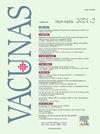Análisis preliminar de las vacunas combinadas frente al virus respiratorio sincitial y el metapneumovirus humano
Q3 Medicine
引用次数: 0
Abstract
La importancia epidemiológica y etiológica del virus respiratorio sincitial (VRS) y del metapneumovirus humano (hMPV) en las infecciones respiratorias de vías bajas, tanto en la población infantil como adulta, determina la necesidad de disponer de una vacuna combinada que proteja frente a ambos virus. Ambos virus poseen un genoma monofilar de ARN de 15,2 kb para el VRS y de 13,3 kb para el hMPV. En ambos virus se han descrito serotipos o subgrupos que cocirculan cada temporada. De las diferentes proteínas que contienen, la F presenta una elevada similitud de estructura y conformación, compartiendo entre un 30–35% de su secuencia para ambos virus; por ello, se ha utilizado para desarrollar vacunas combinadas. Las vacunas combinadas atenuadas utilizan una cepa de hMPV delecionada en el gen SH, que es sustituido por el gen de la proteína F del VRS. Esta cepa se replica en cultivos celulares y ratones, por lo que permitió iniciar un ensayo en ratones. La inmunidad humoral y celular inducida por esta vacuna era heteróloga y abarcaba diferentes subtipos de ambos virus, además, protegía a los animales de la infección exógena. Se han comunicado los datos preliminares de una vacuna de ARN mensajero combinada con la proteína F en su forma preF. Los resultados obtenidos mostraron que ambas vacunas incrementaban el título de anticuerpos neutralizantes frente al VRS-A, VRS-B y hMPV en niños de 5–8 meses y de 8–23 meses, tanto seropositivos como los previamente seronegativos frente a este virus, es decir, que la respuesta inmune es independiente de la presencia previa de anticuerpos.
También está en fase muy preliminar una vacuna quimérica, formada por la cabeza globular de la proteína F del VRS y el tallo del hMPV. Todavía no hay datos definitivos, aunque es muy posible que en un futuro cercano se disponga de una vacuna combinada que prevenga las infecciones por VRS y hMPV.
The epidemiological and etiological importance of respiratory syncytial virus (RSV) and human metapneumovirus (hMPV) in lower respiratory tract infections, both in children and adults, dictates the need for a combined vaccine that protects against both viruses. Both viruses have a single-stranded RNA genome of 15.2 kb for RSV and 13.3 kb for hMPV. Serotypes or subgroups that cocirculate each season have been described for both viruses. Of the different proteins contained in both viruses, the F proteins have a high degree of similarity in structure and conformation, sharing between 30 and 35% of their sequence; therefore, they have been used to develop combined vaccines. Attenuated combined vaccines use a strain of hMPV deleted in the SH gene, which is replaced by the RSV F protein gene. This strain replicated in cell cultures and mice allowing for the initiation of a trial in mice. The humoral and cellular immunity induced by this vaccine was heterologous and encompassed different subtypes of both viruses, and also protected animals from exogenous infection. Preliminary data have been reported on a combined mRNA vaccine with the F protein in its preF form. The results showed that both vaccines increased neutralizing antibody titers against RSV-A and RSV-B, and hMPV in children aged 5–8 months and 8–23 months who were both seronegative and previously seronegative against this virus, meaning that the immune response is independent of the prior presence of antibodies. A chimeric vaccine consisting of the globular head of the RSV F protein and the stem of hMPV is also in the very preliminary phase. Definitive data are not yet available, yet it is quite possible that a combined vaccine that could prevent RSV and hMPV infections will be available in the near future.
对合胞呼吸道病毒/人转肺病毒联合疫苗的初步分析
合胞式呼吸道病毒(VRS)和人转肺病毒(hMPV)在儿童和成人中低呼吸道感染中的流行病学和病因学重要性决定了需要一种联合疫苗来预防这两种病毒。这两种病毒的RNA单链基因组分别为15.2 kb的VRS和13.3 kb的hMPV。这两种病毒的血清型或亚群在每个季节共同传播。在它们所含的不同蛋白质中,F在结构和结构上非常相似,两种病毒的序列共有30 - 35%;因此,它已被用于联合疫苗的开发。减毒联合疫苗使用的是一种从SH基因中删除的hMPV毒株,该毒株由VRS的F蛋白基因替代。该菌株在细胞培养和小鼠中被复制,这使得在小鼠中进行试验成为可能。这种疫苗引起的体液和细胞免疫是异质的,包括这两种病毒的不同亚型,并保护动物免受外源性感染。已经报告了疫苗的初步数据形式的信使rna结合蛋白F preF。结果表明,两种疫苗增加VRS-A对面中和性抗体,VRS-B头衔和hMPV在5—8个月婴儿8—23个月以前,艾滋病毒感染病毒,即独立的免疫反应是预先存在抗体。由VRS蛋白F球形头和HMPV茎组成的嵌合疫苗也处于非常早期的阶段。目前还没有确切的数据,但一种预防VRS和HMPV感染的联合疫苗很可能在不久的将来出现。在儿童和成人中,呼吸道合胞病毒(RSV)和人类甲氧肺病毒(hMPV)在低呼吸道感染中的流行病学和病因学重要性决定了需要一种对这两种病毒都有保护作用的联合疫苗。这两种病毒的单链RNA基因组为15.2 kb的RSV和13.3 kb的hMPV。描述了两种病毒在每个季节共循环的血清型或亚群。在这两种病毒所含的不同蛋白质中,F蛋白在结构和构象上具有高度的相似性,其序列共有30%至35%;因此,它们已被用于开发联合疫苗。减少的联合疫苗使用SH基因中删除的hMPV菌株,该菌株被RSV F蛋白基因取代。这种菌株在细胞培养和小鼠中复制,允许在小鼠中进行试验。这种疫苗诱导的体液和细胞免疫是异质的,包含了两种病毒的不同亚型,也保护了动物免受外源性感染。一种结合F蛋白的mRNA联合疫苗的初步数据已被报道。结果显示,在5 - 8个月和8 - 23个月的儿童中,这两种疫苗都增加了对RSV-A和RSV-B以及hMPV的中和抗体滴剂,这些儿童对该病毒都是血清阴性和以前的血清阴性,这意味着免疫反应与之前的抗体存在无关。一种由RSV F蛋白球状头和hMPV干细胞组成的嵌合疫苗也处于非常初级的阶段。目前还没有确切的数据,但很有可能在不久的将来会有一种预防RSV和hMPV感染的联合疫苗。
本文章由计算机程序翻译,如有差异,请以英文原文为准。
求助全文
约1分钟内获得全文
求助全文
来源期刊

Vacunas
Medicine-Infectious Diseases
CiteScore
3.90
自引率
0.00%
发文量
138
审稿时长
62 days
期刊介绍:
Sin duda una de las mejores publicaciones para conocer los avances en el campo de las vacunaciones preventivas, tanto en el ámbito de la investigación básica como aplicada y en la evaluación de programas de vacunaciones. Su alta calidad y utilidad la ha llevado a estar indexada en los prestigiosos índices IME y SCOPUS.
 求助内容:
求助内容: 应助结果提醒方式:
应助结果提醒方式:


